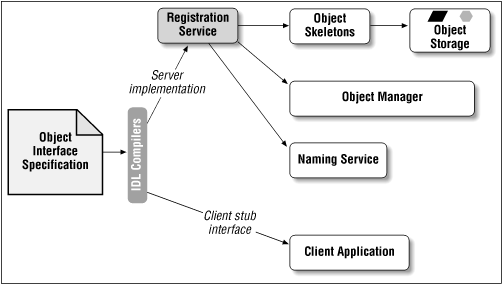Features of Distributed Object Systems
From our exercise in the previous section, we uncovered some of the features that distributed object systems need. These features, plus some others, are illustrated in Figure 3.1. An object interface specification is used to generate a server implementation of a class of objects, an interface between the object implementation and the object manager, sometimes called an object skeleton , and a client interface for the class of objects, sometimes called an object stub. The skeleton will be used by the server to create new instances of the class of objects and to route remote method calls to the object implementation. The stub will be used by the client to route transactions (method invocations, mostly) to the object on the server. On the server side, the class implementation is passed through a registration service , which registers the new class with a naming service and an object manager, and then stores the class in the server’s storage for object skeletons.
 |
With an object fully registered with a server, the client can now request an instance of the class through the naming service. The runtime transactions involved in requesting and using a remote object are shown in Figure 3.2. The naming service routes the client’s request to the server’s object manager, which creates ...
Get Java Distributed Computing now with the O’Reilly learning platform.
O’Reilly members experience books, live events, courses curated by job role, and more from O’Reilly and nearly 200 top publishers.

